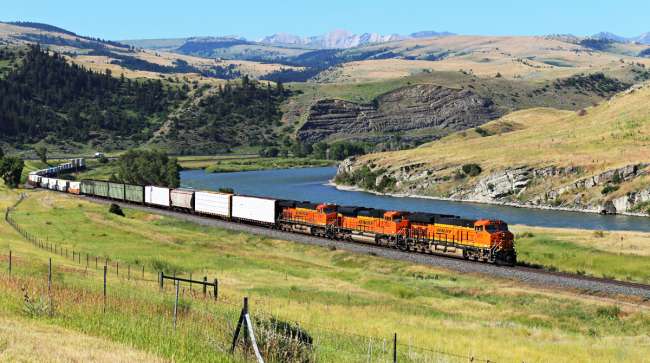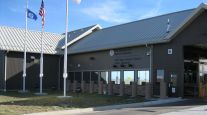Staff Reporter
ASCE’s December Scorecards Reveal Cs for Montana, Nevada

Montana and Nevada, the states that the American Society of Civil Engineers assessed in December, earned overall C grades for infrastructure.
Both states’ grades are slight improvements from the C- scores they earned on their previous report cards.
Montana’s scorecard, released Dec. 6, examined 10 aspects of the state’s infrastructure: bridges, dams, drinking water, energy, rail, roads, schools, solid waste, storm water and wastewater.
Montana ASCE Scorecard by Transport Topics on Scribd
In Montana, rail scored the highest with a B. Schools performed the worst with a D-.
Roads, which earned a C-, experienced a slight drop in quality since Montana’s last comprehensive scorecard in 2014. Some 46% of the state’s major roads are in poor to mediocre condition. The report notes that, in 2014, about 21% of the pavement on the state’s National Highway System roads was in poor to fair condition. In 2016, ASCE found 29% of that pavement was in poor to fair condition.
The report notes that Montana’s roads, rarely clogged by congestion, are used to move $101 billion worth of goods by truck each year. The U.S. Census Bureau estimated that Montana had a population of slightly more than 1 million people in 2017.
“We do have a lot that is really great about our road network. We have some of the least crowded roads in the country,” Dan Karlin, outreach chair of Montana ASCE’s section, told Transport Topics. “It’s a very large state. It’s a pretty small population. Capacity’s great, but our condition’s kind of tough.”

We're between seasons on RoadSigns but have created an intersession season as we get set for 2019. In Episode 1, we ask: How Does Congress Say Trucking? Are the planets finally aligning for movement on infrastructure funding? Hear a snippet above from Kellie Mejdrich of CQ Roll Call, and get the full program by going to RoadSigns.TTNews.com.
Montana’s severe weather can harm pavement on roadways, Karlin said. He said he has seen the weather shift from snow to 60 degrees and back to snow, all in the same day. Such fluctuations can lead to freeze-thaw cycles, which is when rain or melted snow seeps into cracks in the road and freezes, thus pushing the pavement apart.
“Pavement doesn’t like that so much. It has a tendency to crack and separate, and there’s an opportunity for more water to get in there,” Karlin said. “Montana’s a northern state. We have weather extremes.”
Nevada’s roads performed only slightly better than Montana’s, earning a C. According to the report card, which was issued Dec. 19, the state faces a $450 million backlog of road and bridge repairs, most of which are needed in rural areas.
Chuck Joseph, chair of the Nevada Report Card Committee, identified increased capacity needs and the region’s rugged climate as challenges for maintaining roads. The Census Bureau estimates that Nevada’s population is just more than 3 million people, a 12% increase from its population in 2010.
RELATED: Southern Nevada’s freight corridor gets the Vegas treatment
Joseph explained that Nevada’s desert climate can strain the state’s road network.
“It gets very cold up there. It’s very dry as well, which tends to dry out anything, especially asphalt,” Joseph said. “Suddenly, you have a lot of mileage to cover just to do crack repair.”
In addition to roads, Nevada’s scorecard assessed aviation, bridges, dams, drinking water, energy, parks, schools, solid waste, storm water, transit and wastewater.
Bridges, energy, parks and wastewater earned a B-, creating a four-way tie for top score. Dams performed the worst with a D+.
Nevada ASCE Scorecard by on Scribd
The report cards stress the importance of infrastructure investment, particularly because both states are home to sprawling networks of roads and relatively small populations of taxpayers to pay for them.
Recommendations outlined in both report cards include raising revenue at the local level and exploring the possibility of increased taxes.
“This often leaves less populated areas grappling with severe underinvestment and aging and neglected systems,” ASCE states in its report for Montana. “Investing in infrastructure will ensure economic stability in our rural areas and improve our residents’ well-being.”
Montana’s Legislature passed a fuel tax increase of 4.5 cents in 2017 in an effort to increase funding for maintenance, preservation and bridge construction. While Nevada hasn’t adjusted its fuel tax since 1992, its two largest counties — Clark and Washoe — recently approved tax measures to raise funds for roads. Joseph described both of those measures as “big positives.”
Current federal rates, which are 24.4 cents per gallon on diesel and 18.4 cents per gallon on gasoline, remain untouched since 1993. Karlin acknowledged that an increase to the federal fuel-tax rate undoubtedly would bolster infrastructure investment at the state level.
“If they were to increase that gas tax at the federal level,” Karlin said, “all it could really do is help states’ and counties’ abilities to do what they’re trying to do now.”



